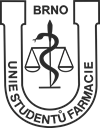STUDENTSKÁ VĚDECKÁ KONFERENCE
MAGISTERŠTÍ STUDENTI
26. 4. 2022
9:00 - 13:30, Pavilon farmacie I
Program chemické a biologické sekce
Pavilon farmacie I
-
9:00 - 9:15
Zahájení
-
9:15 - 10:00
Photon-Upconversion Nanoparticles: A New Type Of Luminescence Label For Protein Marker Detection, Biological Imaging And Microfluidics
Antonín HLAVÁČEK1*, Jana KŘIVÁNKOVÁ 1, Julie WEISOVÁ 1, František FORET 1
1Department of Bioanalytical Instrumentation, Institute of Analytical Chemistry of the Czech Academy of Sciences, v. v. i., Veveří 967/97, 602 00 Brno; *hlavacek@iach.cz
UCNPs are nanocrystals doped with lanthanide ions that emit visible luminescence when excited with near-infrared wavelengths (Zhou et al., 2015). The advantages of photon‑upconversion include narrow emission bands, negligible autofluorescence, and high stability. Therefore, they find application in immunochemical methods where they replace enzyme and fluorescence labels (Hlaváček et al., 2022). A certain disadvantage of UCNPs is emission at multiple wavelengths simultaneously, which property prevents a parallel detection of multiple UCNP types. We have recently overcome this limitation by using a non-negative least squares algorithm and used it for microdroplet encoding (Hlaváček et al., 2019, 2020). We now consider a broader application of this approach. We have developed a photon‑upconversion scanner that enables photon-upconversion imaging on planar surfaces. With this approach, we have realized three independent detection channels with three types of UCNPs doped with either Er3+, Ho3+, or Tm3+. We also discuss methods for parallel detection and imaging of several types of molecules.
ACKNOWLEDGEMENTS
We acknowledge the support from the Czech Science Foundation (21-03156S) and the Institute of Analytical Chemistry of the Czech Academy of Sciences, v.v.i. (RVO 68081715).
REFERENCES
Hlaváček, A. et al. (2019) ‘Photon-Upconversion Barcoding with Multiple Barcode Channels: Application for Droplet Microfluidics’, Analytical Chemistry, 91(20), pp. 12630–12635. doi:10.1021/acs.analchem.9b03117.
Hlaváček, A. et al. (2020) ‘Photon-upconversion barcode for monitoring an enzymatic reaction with a fluorescence reporter in droplet microfluidics’, Analyst [Preprint]. doi:10.1039/D0AN01667E.
Hlaváček, A. et al. (2022) ‘Bioconjugates of photon-upconversion nanoparticles for cancer biomarker detection and imaging’, Nature Protocols, 17(4), pp. 1028–1072. doi:10.1038/s41596-021-00670-7.
Zhou, B. et al. (2015) ‘Controlling upconversion nanocrystals for emerging applications’, Nature Nanotechnology, 10(11), pp. 924–936. doi:10.1038/nnano.2015.251.
-
10:00 - 10:15
Synthesis of pyrrole derivates as potential therapeutics
Kristína Jánošíková1
1 Department of Chemical Drugs, Faculty of Pharmacy, Masaryk University, e-mail: 507283@mail.muni.cz
Key words: metalloenzymes, metal, potential inhibitors, development of inhibitors, pyrrole synthesis
Proteins which require metal ion for their catalytic function are generally known as metalloenzymes. They are central to a wide range of essential biological activities, including nucleic acid modification, protein degradation, and many others. Numerous metalloenzymes are considered as promising drug targets. Their overexpression, enhanced activation or misregulation might result in propagation of many diseases including cancer, hypertension, diabetes, AIDS, bacterial infection, inflammatory, and neurodegenerative diseases. The aim of this work is to prepare new compounds as potential inhibitors of metalloenzymes.
To achieve this goal, six step linear synthesis of pyrrole derivates was designed. In the initial step, starting molecule for pyrrole synthesis was prepared. Pyrrole ring formation was accomplished in second step and it was subsequently transformed to carboxylic acid. In fourth step, aniline ring was attached to the molecule. Methyl ester was hydrolyzed and, in the last step, substituted anilide was synthesized. The purity and structures of prepared products were analyzed by TLC, NMR and MS spectrometry.
In this work, new potential inhibitor of metalloenzyme was synthetized. Various intermediate preparation methods were tested during the synthesis to optimize outcome of individual reactions and to obtain the final product.

Acknowledgement: This study was supported by Masaryk University projects: MUNI/A/1682/2020 and MUNI/C/0015/2021.
Supervisor: Mgr. Hana Pížová, Ph.D.
-
10:15 - 10:30
Synthesis and Structural Analysis of (3-Alkyl)-1H-Indole-2-Carboxylic Acid Derivatives With Potential Cardiovascular Activity
Pavel Horák 1, Petr Mokrý 1
1 Department of Chemical drugs, Faculty of Pharmacy, Masaryk University
Key words: indole acid derivatives, antianginal effect, antiischemic effect, synthesis
The main goal of this experimental study was synthesis and structural analysis of (3-alkyl)-1H-indole-2-carboxylic acid derivatives. These molecules were synthesized with an expectation of their antiischemic and antianginal effects. Specifically, it was a preparation of (3-alkyl)-1H-indole-2-carboxylic acid esters (Fig. 1), as the alcohol part of the molecule was used piperazine structural fragment derived from the molecule of ranolazine (Fig. 2). Experimental work contains three separate five to nine-step synthesis. Every synthesis started with different derivative of this carboxylic acid. The result of these synthesis were six final compounds. These substances were transferred to fumarates for increasing their bioavailability. The identity of all synthesized molecules and isolated intermediates was verified by analytical methods (NMR, IR) and physico-chemical methods (Melting point, TLC).


Acknowledgement: The study was supported by the project MUNI/A/1682/2020
Supervisor: Mgr. Petr Mokrý, Ph.D.
-
10:30 - 10:45
Isolation of Active Constituents From Fractions Obtained From Paulownia Tomentosa Fruit Using Various Chromatographic Methods
Tereza Štaffová 1
1 Department of Natural Drugs, Faculty of Pharmacy, Masaryk University
Key words: prenylated flavonoids,antimycotic activity,Paulownia tomentosa, chromatography, indetification
Paulownia tomentosa is a plant of traditional Chinese medicine. This fast-growing woody plant is a rich source of a diverse mixture of secondary metabolites such as flavonoids, lignans terpenes, phenolic glycosides and others. The fruits contain prenylated reps. geranylated flavonoids, which have significant biological activity. Therefore, part of the work was focused on prenylated flavonoids and their effect on pathogenic fungi. According to studies, these substances could have applications in the development of new antifungal drugs.
Furthermore, this work was focused on the isolation and identification of substances from Paulownia fruits. The selected fraction was PT3O/24–28, which was separated by various chromatographic methods into several subfractions. Four substances that have been recovered in sufficient purity and quantity have been identified. UV/Vis spectrometry, IR, HRMS, NMR, and CD techniques were used for the structure elucidation.
The substances were identified as acylglycerols 2-O-[(3R)-3-(acetyloxy)octadecanoyl]glycerol (Fig. 1) and 2-O-[(3R)-3-(acetyloxy)eicosanoyl]glycerol (Fig. 2) and euscaphic acid (Fig. 3), which belongs to the group of triterpenes. Eusaphic acid have been described in P. tomentosa for the first time. The exact structure of the last obtained molecule with a conjugated bond system has not yet been determined. Isolated substances could be subjects for biological activity studies.
![Fig. 1: 2-O-[(3R)-3-(acetyloxy)octadecanoyl]glycerol](https://cdn.muni.cz/media/3409434/staffova1.png?mode=crop¢er=0.5,0.5&rnd=132950125680000000&width=252)
![Fig. 2: 2-O-[(3R)-3-(acetyloxy)eicosanoyl]glycerol](https://cdn.muni.cz/media/3409436/staffova2.png?mode=crop¢er=0.5,0.5&rnd=132950125690000000&width=250)

Supervisor: PharmDr. Lenka Molčanová
-
10:45 - 11:00
Separation of Content Compounds From Fruits of Sorbus Domestica With Potential Antidiabetic Activity
Michaela Krč-Konečná 1, Milan Malaník 1
1 Department of Natural Drugs, Faculty of Pharmacy, Masaryk University
Key words: Sorbus domestica, diabetes mellitus, chromatographic methods, antidiabetic activity, pentacyclic triterpenoids
Sorbus domestica is a fruit tree which belongs to endangered species in our geographical conditions. Its fruits are used mainly to produce compotes, jams and alcoholic beverages. However, in some countries, it is also used in folk medicine, for example as an adjuvant antidiabetic drug. The aim of this thesis was to find out more about content compounds of this plant and eventually confirm its use in the treatment of diabetes mellitus (DM).
The theoretical part was focused on already identified compounds in S. domestica and their antidiabetic activity. The purpose of the experimental part was to analyze and separate substances with potential antidiabetic effects. Substances were isolated from the chloroform part of an ethanolic extract of S. domestica fruits using chromatographic methods (column chromatography and preparative HPLC).
The result of the experimental part confirmed the presence of glucose and fructose in the fruits of S. domestica. It was reached by comparing HPLC-ELSD chromatogram of our sample with HPLC-ELSD chromatograms of standards of glucose and fructose. We also managed to isolate several bioactive compounds whose structural properties were analysed by NMR and IR spectroscopy. These compounds were identified as p-coumaric acid, linalool-3,6-oxide-β-D-glucopyranoside, euscaphic acid, maslinic acid, corosolic acid, ursolic acid and oleic acid. There is no mention in the scientific literature of the presence of these substances in S. domestica.
According to the literature, obtained pentacyclic triterpenoids show antidiabetic activity in studies, so they could contribute to the antidiabetic effect of S. domestica. They are involved in the regulation of glucose absorption, prevention from long-term diabetes complications and improvement of insulin resistance. Therefore, further research could be carried out to confirm the potential of S. domestica in the therapy of DM and prevention of diabetic complications.
Supervisor: PharmDr. Milan Malaník, Ph.D.
-
11:00 - 11:15
Isolation of Coumarins of Broussonetia Papyrifera With Potential Anticonvulsant Activity
Terézia Michalíková 1
1 Department of Natural Drugs, Faculty of Pharmacy, Masaryk University
Key words: Broussonetia papyrifera, coumarins, 1H NMR-guided separation, identification, anticonvulsant activity
This study was mainly focused on targeted isolation and identification of coumarins, a class of secondary metabolites, of Broussonetia papyrifera (L.) L'Hér. ex Vent. (Moraceae) using the approach of 1H NMR-guided separation. The experiment was performed on fractions that were obtained from the chloroform portion of an ethanolic extract derived from the wooden parts of B. papyrifera. To determine individual fractions that might contain coumarins, all the fractions were initially subjected to UV spectra analysis using the pre-existed data measured by previous students. Each of the selected fractions was subsequently analyzed using 1H NMR spectroscopy. The chemical structures of coumarins consist of a lactone ring, whose hydrogen atom at the C4 position typically shows a chemical shift at δH 7.80–8.20 ppm, that usually displays at the 1H NMR spectra as a doublet. Fractions, in which the presence of monitored signals was confirmed, were further separated using a semi-preparative HPLC. Their exact chemical structures were identified by spectroscopic methods (UV, IR, MS, NMR, CD).

Described separation technique was successfully applied, and as a result, several different coumarins were isolated, namely marmesinin, rutaretin, smyrindiol, marmesin and mixture of marmesin and 8-methoxymarmesin. Moreover, the first three mentioned coumarins have been documented in B. papyrifera for the first time. Considering the achieved outcome, this approach will be surely reapplied to other plant sources rich in coumarins in the future.
Acknowledgement: This research was financially supported by the project MUNI/A/1688/2020 and by Grant Agency of Masaryk University within the Excellent diploma thesis program. Project number: MUNI/C/0042/2021. The contribution of the Czech Sciences Foundation (grant no. CSF Bilateral AT-CZ 21-38204L) is also gratefully acknowledged.
Supervisor: PharmDr. Milan Malaník, Ph.D.
-
11:15 - 11:30
Přestávka
-
11:30 - 11:45
Novel Potential Histone Deacetylase Inhibitors And Their Proapoptotic Effects in Cancer Cells
Martina Dvořáková 1, Peter Kollár 1, Magdaléna Onuščáková 2, Pavel Bobáľ 2, Tereza Kauerová 1
1 Department of Pharmacology and Toxicology, Faculty of Pharmacy, Masaryk University
2 Department of Chemical Drugs, Faculty of Pharmacy, Masaryk UniversityKeywords: histone deacetylase inhibitors, vorinostat, hydroxamic acids, histones, apoptosis
Epigenetic-targeted therapy is a promising strategy for anticancer treatment. In the group of epigenetic anticancer agents, we find inhibitors of histone deacetylases (iHDACs), that regulate the acetylation of histones and chromatin remodeling. iHDACs thus affect different cellular processes, such as induction of apoptosis. They activate both the intrinsic and extrinsic apoptotic pathways and cause cell death, especially by inducing caspase 3 activation. A group of hydroxamic acids belongs to iHDACs and are already used to treat cancer (such as vorinostat, panobinostat, or belinostat).
Our research studied the biological activity of new derivates of hydroxamic acids as potential histone deacetylase inhibitors designed and synthesized by the Department of Chemical Drugs, Faculty of Pharmacy, Masaryk University. In particular, our study was focused on evaluating their potential to affect histone acetylation and to induce apoptosis in the monocytic leukemia cell line compared with vorinostat. Based on the results of antiproliferative effects of the new group of hydroxamic acids, we selected the most active compounds for further analysis. The Western blotting assay showed that these compounds changed the acetylation of various types of histones as vorinostat did. These compounds also induced an increase in the subdiploid population which can be considered as a non-specific marker of induced apoptosis. The following study of the proapoptotic activity indicated the potential of tested compounds to induce phosphatidylserine translocation, activate caspase 3, and cleave PARP.
These results suggest that the novel group of hydroxamic acids might represent a potential model structure for developing novel histone deacetylase inhibitors, and it deserves further detailed research on the molecular basis of the possible antitumor effect.
Acknowledgement: The study was supported by the project MUNI/A/1598/2020.
Supervisor: PharmDr. Tereza Kauerová, Ph.D.
-
11:45 - 12:00
Effects of Novel Hydroxamic Acids On Cell Cycle Progression And Cytodifferentiation
Jana Melicharová 1, Tereza Kauerová 1, Magdaléna Onuščáková 2, Pavel Bobáľ 2, Peter Kollár 1
1 Department of Pharmacology and Toxicology, Faculty of Pharmacy, Masaryk University
2 Department of Chemical Drugs, Faculty of Pharmacy, Masaryk University, Czech RepublicKeywords: histone deacetylase inhibitors, cell cycle, cytodifferentiation, vorinostat, hydroxamic acids
Dysregulation of histone deacetylases activity plays a causative role in the etiology of various clinical disorders such as cancer. The induction of the activity change of histone deacetylases is one of the promising approaches in the field of anticancer therapy. It is assumed that the anticancer mechanisms of inhibitors of histone deacetylases (iHDACs) are related to the suppression of cell cycle progression and induction of cytodifferentiation. HDAC inhibitors are already used in the therapy of some neoplastic diseases, such as hydroxamic acid’s analogue vorinostat (SAHA) in case of cutaneous T-cell lymphoma. Moreover, recent studies suggest promising results in using iHDACs for the therapy of a wider range of hematologic malignancies.
At the Department of Chemical Drugs of the Pharmaceutical Faculty, Masaryk University, a new group of hydroxamic acids was designed and synthesized based on similarity to the structure of vorinostat. The aim of the project was to evaluate the effects of selected new hydroxamic acids on the processes of cell cycle progression and cytodifferentiation in the monocytic leukemia cell line and to compare these effects with the activity of a reference substance, vorinostat. Flow cytometric analysis of cell cycle progression revealed an increase in the frequency of cells in the G1 phase of the cell cycle after exposure to the test substances, qualitatively comparable with the vorinostat effect. This finding was supported by Western blotting results of level changes of selected cell cycle regulators. Afterward, the NBT reduction assay, together with the expression of the surface marker CD11b analysis, performed on THP-1 cells, indicated the potential of tested compounds and vorinostat to induce cytodifferentiation.
The results obtained in this study contributed to the extensive research of in vitro biological activity of a series of new hydroxamic acids with anticancer potential.
Acknowledgement: The study was supported by the project MUNI/A/1598/2020.
Supervisor: doc. PharmDr. Peter Kollár, Ph.D.
-
12:00 - 12:15
Biochemical Markers Of Brain Damage In Middle Cerebral Artery Occlusion Model In Rat And Rabbit
Tereza Hošová, Jana Hložková 1, Peter Scheer 1
1 Department of Pharmacology and Toxicology, Faculty of Pharmacy, Masaryk University
Key words: biomarkers, stroke, animal models, brain occlusion
Background and Aims
The research is concerned with finding suitable biochemical markers of cerebral vascular damage on a model of occlusion of the middle cerebral artery (MCAO) in a rat and rabbit. Cellular fibronectin, matrix metalloproteinase 9, D-dimers and brain natriuretic peptide (NTproBNP) were determined and studied as biomarkers. The aim of the study is to evaluate changes in plasma levels of potential markers of cerebral damage.
Methods
For this research, plasma collected from 50 rats and 50 rabbits after 24-hour induction of MCAO was used. D-dimers and NTproBNP were determined using iCHROMA II. This is an immunofluorescence test for the quantitative determination of biomarkers. Matrix metalloproteinase 9 and cellular fibronectin were determined using an ELISA, based on a specific antigen-antibody interaction. The f-test, t-test, and Pearson correlation coefficient were used for statistical evaluation of obtained data.
Results
In rats, there was a significant positive correlation between cellular fibronectin and hemorrhagic transformation type 2 and a non-significant negative correlation between MMP9 and ischemia and between MMP9 and hemorrhagic transformation 1+2. D-dimers and natriuretic peptides type B did not show statistically significant results with ischemia and hemorrhagic transformation.
In rabbits, there was no correlation between cellular fibronectin and ischemia or hemorrhagic transformation. Plasma levels of MMP9 were not correlated with ischemic damage, but there was a significant positive correlation with hemorrhagic transformation 1+2. There was no correlation with ischemia or hemorrhagic transformation in d-dimers and the same results were obtained for correlations with natriuretic peptide type B.
Conclusions
The results obtained from measurements of d-dimers and NTproBNP indicate that biochemical markers did not exceed the cut-off level and that there was no circulatory or cardiac failure or possible perisurgical thrombosis during anesthesia.
In rabbits, plasma levels of cellular fibronectin revealed low sensitivity to ischemic lesions and hemorrhagic transformations. Plasma levels of MMP9 showed a significant positive correlation with hemorrhagic transformations 1+2.
In rats, a median correlation was found between cellular fibronectin and type 2 bleeding, which may indicate acute vascular damage and the relevance of MMP9 as a biochemical marker for hemorrhagic transformation was not confirmed.
Author's CV: Tereza Hošová is a student of the fifth year at Faculty of pharmacy at Masaryk University in Brno. Pharmacy is a field that she has always been very interested in and enjoyed. She is interested in research and so that is why she decided to collaborate on this experimental research.
Supervisor: MVDr. Jana Hložková, Ph.D.
-
12:15 - 12:30
Detection Of MicroRNA Biomarkers Of Brain Damage In Rats
Kim Kallala 1, Jana Hložková 1, Peter Scheer 1, Tereza Báťková 2
1 Department of Pharmacology and Toxicology, Faculty of Pharmacy, Masaryk University
2 BioVendor – Laboratorni medicina a.s., Brno, Czech RepublicKey words: miRNA, stroke, biomarker, rat, animal model
Background and Aims
The aim of this work was to isolate and detect miR-124-3p, miR-210-3p, miR-451-5p and miR-155-5p in brain tissue samples of rats with histologically proven and unproven ischemic brain infarct, to evaluate the differences in expression profiles of these miRNAs in each group and to determinate their significance as potential biomarkers of brain stroke.
Methods
For the purposes of this experiment, 27 samples of rat brain tissue were selected and divided into 2 groups. The first group "ischemia +" included 18 samples with histologically proven ischemia and the second group "ischemia -", included 9 samples of healthy unaffected brain tissue. miRNA isolation was performed using the FFPE Tissue miRNA Isolation Kit from BioVendor - Laboratorní medicína a.s. (Brno, Czech Republic) and the TT-RT-qPCR method was used for miRNA detection. The results were then statistically evaluated using the Mann-Whitney nonparametric statistical test.
Results
Changes in the expression profiles of each miRNA between the "ischemia +" and "ischemia -" groups were identified and their fold changes (FCH) were calculated. This value indicates how many times the miRNA expression in the "ischemia +" group is higher than in the "ischemia -" group. MiR-124-3p (FCH = 2.07; p = 0.2703), miR-451a-5p (FCH = 3.07; p = 0.1052), miR-210-3p (FCH = 1.27; p = 0.2917), miR-155-5p (FCH = 2.45; p = 0.0124). Only for miR-155-5p was the difference statistically significant (p = 0.0124 <0.005). In order to verify the performance of the assay in the miR-155-5p expression profile analysis, a receiver operating characteristic analysis was performed. The area under the curve value of 0.816 indicated that the test performance is moderate.
Conclusions
MiRNAs were successfully isolated and detected in both groups and their expression profiles were statistically evaluated. A statistically significant difference was observed for miR-155-5p. The expression of this miRNA was upregulated in the "ischemia +" group compared to the "ischemia -" group. Thus, the results of this research confirm the importance of miR-155-5p as a potential biomarker of ischemic stroke.
Author's CV: Kim Kallala is a fifth-year student at the Faculty of Pharmacy in Brno. In the framework of her diploma thesis, she had the opportunity to work on a topic that has fascinated her for a long time and to get acquainted with several innovative methods.
Supervisor: MVDr. Jana Hložková, Ph.D.
-
12:30 - 12:45
Evaluation Of Inhibitory Activity Of Selected Quaternary Ammonium Salts Against Staphylococcus Epidermidis Biofilm
Michaela Králová 1
1 Department of Molecular Pharmacy, Faculty of Pharmacy, Masaryk University
Key words: Quaternary ammonium salts, antibiofilm activity, Staphylococcus epidermidis
Introduction
Frequent use of antibiotics leads to the development of resistance in several bacterial strains. Bacterial resistance to antimicrobials is related to their ability to form a biofilm – i.e., a microbial community representing a form of protection for bacteria. Therefore, it is necessary to synthesize new substances or alter the structures of those already in use to find new ones with antimicrobial or antibiofilm activity.
Aim
The aim of this project was to experimentally determine whether selected substances from the group of quaternary ammonium salts (QAS; synthesized at Dpt. Of Chemical Drugs) reduce the formation of a bacterial biofilm produced by the gram-positive bacteria Staphylococcus epidermidis.
Methods
The experiment included testing the minimum inhibitory concentration of these substances using the microdilution method. The inhibitory activity on bacterial biofilm formation was determined by the crystal violet staining method.
Results
Among the QAS tested, compound 13 was the most active - reducing production of biofilm by 34% at concentration 32 microg/ml (p<0.05). In my opinion, this should by subject of further research.
![Chemical compound 13: 4‐[3‐(4‐butoxyphenoxy)‐2‐hydroxypropyl]‐1‐(4‐nitrophenyl)piperazine‐1,4‐diium dichloride](https://cdn.muni.cz/media/3407478/kralova.png?mode=crop¢er=0.5,0.5&rnd=132942374550000000&width=250)
Supervisor: PharmDr. Jakub Treml, Ph.D.
-
12:45 - 13:15
Zasedání odborných hodnoticích komisí
-
13:15 - 13:30
Vyhlášení výsledků
-
od 13:30
Diskuze s občerstvením













